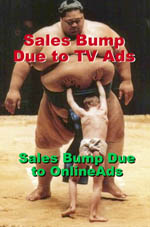Is Online Pharma Advertising ROI Scalable? Outsize Results on Modest Spends May Not Scale Up
By John Mack
 At the 6th Annual Digital Pharma East conference in Philadelphia, October 15-18, 2012, I met many “old” friends including Bill Drummy, CEO of HeartBeat Ideas.
At the 6th Annual Digital Pharma East conference in Philadelphia, October 15-18, 2012, I met many “old” friends including Bill Drummy, CEO of HeartBeat Ideas.
Drummy’s presentation had a long and somewhat complicated title — “Outsize Results on Modest Budgets: Think You Can’t Afford World-Class Marketing on Your Limited Budget? Think Again” — but his message was simple: the ROI of online promotion is an order of magnitude greater than the “typical” 2:1 ROI for non-digital channel promotion (see “DTC ROU,” below).
“With digital you can get way more bang for your buck,” said Drummy, “so you HAVE to think of the digital channel. If you have a real insight about your target, use really bold creative, and use a lot of precision targeting and pay-for-performance techniques, you can get dramatically higher and better results.”
Drummy then said that ROI for digital ranges from 4:1 on the low end to high double digits on the high end. He’s seen digital ROIs of about 29:1 in “a number of different cases.” That’s return on investment measured by increased sales, not surrogate key performance indicators like ad impressions, clicks and Facebook likes, etc.
Drummy didn’t go into too much detail about how these ROI are measured, but he did show a blinded digital promotion case study (paid search and online display) where the ROI was about 5:1 (it was 13:1 for just paid search). The spend on that promotion was $32,000, I believe.
My question is this: Is this scalable to the point where digital promotion gives you a significant bump in sales?
A 5:1 ROI on a spend of $32,000 translates into $160,000 in additional sales. This is a small number as far as Rx sales go. A TV ad campaign spend of $100 million at 2:1 ROI results in $200 million in additional sales — now we’re talking about a real bump. At 5:1 ROI, how much money would you need to spend on search/display ads to realize a bump of $200 million? You would have to spend $40 million! I contend that it is impossible to spend that amount of money in one year on paid search and display advertising. And, if it was possible, would the ROI still be greater than the traditional, non-online ROI of 2:1?
If Drummy knows of a case to disprove this, I’d like to hear about it.
To be fair, Drummy was talking to companies with LIMITED budgets for promotion. In that case, there are probably limited sales opportunities as well. Therefore, putting your limited promotion budget into digital makes sense.
DTC ROI
Although there is much controversy surrounding DTC ROI, most published data on ROI for DTC show positive results.
On one hand, one industry expert estimated that ROI for DTCA (direct-to-consumer advertising) is in the range of $1.60 to $2.00 per every dollar invested and some estimates are as high as $4.00 per dollar invested.
On the other hand, a study by Dartmouth College concluded that the overall median ROI for DTC was only $0.19 and several brands had negative ROIs! “DTC ROI ranged up to $1.37, depending on brand size/launch date,” was the best it could say about DTC.
Needless to say, the RAPP study, which was sponsored by the Association of Medical Publications (not an unbiased entity), is often criticized by pharmaceutical marketers. An IMS study, in particular, countered the RAPP study using a different methodology and concluded that “Seventy percent of the brands analyzed have an ROI in excess of $1.50 for each dollar invested; 35 percent were in excess of $2.50. The best performing brand in the study yielded an ROI of $6.50 per dollar invested.”
Why I am wary of vendor claims when it comes to pharma marketing
From World of DTC Marketing Blog
“I checked my drivers license and according to the information I was not born yesterday so excuse me if I doubt that anyone could achieve an ROI of 20:1 for an online media program,” said Rich Meyer, author of World of DTC Marketing Blog. “Is this what pharma marketing has come to? Agency people making outrageous claims to promote more business?”
“If I am not mistaken the ROI statement was based on a testosterone product for men,” said Meyer. “First, it’s important to note that the TV spots for this product have been running with increased frequency and reach. Now most men are slugs when it comes to their health so they are not going to rush to their computers or iPad’s to get information on a prescription testosterone product. However when they see an online ad it may nudge them to get more information. My point is that in this case both online and offline work together to drive marketing objectives. To claim that the online ad was solely responsible for an ROI of 20:1 is not realistic.”
Some comments from readers:
- “Our DTC audits track 42% of all DTC spending in US and include all media strategies. To answer your question about is it scalable, I’d have to review cross category date, but I have seen digital only campaigns reach 25% of a disease category audience. That reach and bolster in this medium via frequency. And frequency, which we measure, is bolstered by multiple messaging. The more focused the theme with variation the more memorable along with brand associated and unique graphics. In our syndicated study we measure lift to patient initiated brand discussions. We include all brands including those with just websites and can track lift when they start a campaign. This is a great question, and an extremely important one when brands want to drop down on TV but are worried how far and how to maintain scale….or reach into the undiagnosed or diagnosed and untreated.” — Doug Zabor, Phoenix Marketing International
PMN119-01
Issue: Vol. 11, No. 9: October 2012



![6 Digital Tools at the Center of Healthcare Digitalization [INFOGRAPHIC]](http://ec2-54-175-84-28.compute-1.amazonaws.com/pharma-mkting.com/wp-content/uploads/2021/04/6DigitalTools_600px-218x150.jpg)




![6 Digital Tools at the Center of Healthcare Digitalization [INFOGRAPHIC]](http://ec2-54-175-84-28.compute-1.amazonaws.com/pharma-mkting.com/wp-content/uploads/2021/04/6DigitalTools_600px-100x70.jpg)




